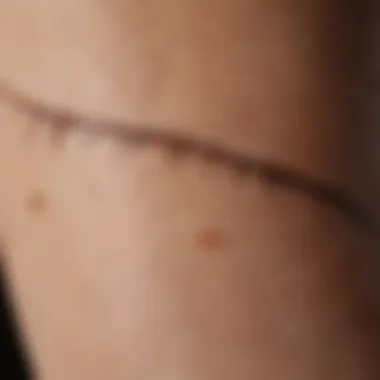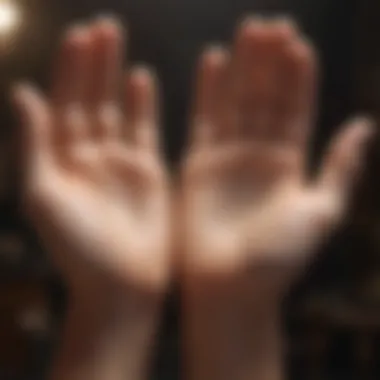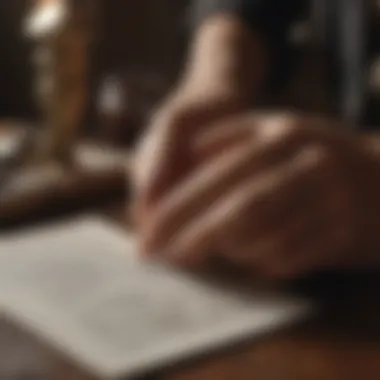Understanding the Life Line: Insights into Palmistry


Intro
The lifeline is a crucial element in the practice of palmistry, often misunderstood yet highly significant. Its location and shape can hint at various aspects of an individual’s personal journey. Insights drawn from the lifeline may extend into areas such as health, vitality, and even emotional well-being. Understanding how it functions within the broader practice of palmistry is vital for effective interpretation.
The lifeline is typically found in the lower part of the palm, spanning from the edge near the thumb to the wrist. While many people believe it merely indicates the length of a person’s life, this interpretation is overly simplistic. A deeper exploration reveals that the lifeline can indicate the quality of life and the courses one may take throughout their existence.
In this article, we will dissect the lifeline’s placement, its implications, and contrasting interpretations in both traditional and modern contexts. We will also consider how hand dominance can affect readings. By offering detailed guidance on how to read one's own lifeline, we aim to enrich your understanding of this intricate subject.
Understanding the Lifeline
Overview
The lifeline is not merely a reflection of longevity but encompasses various experiences and challenges one faces. It can change over time as a result of major life decisions or events. The way the lifeline interacts with other lines—such as the heart line and head line—can also offer vital clues into one’s emotional and intellectual disposition.
Shape and Length
The shape and length of the lifeline carry different meanings:
- Curved and long: Often suggests a life filled with vitality and rich experiences.
- Straight and short: May indicate caution or a more reserved lifestyle.
- Breaks also signify significant life changes or upheavals.
Interpretations
Each lifeline is unique, and interpretations can vary significantly:
- A lifeline that appears prominent may imply strong instincts and adventurous spirit.
- A faint lifeline relates to self-doubt or a tendency to shy away from risks.
- Forks in the lifeline suggest choices or different paths taken in life.
"The lifeline does not inherently predict death. Instead, it provides insight into how one navigates through life's complexities."
Influence of Hand Dominance
The dominant hand usually represents your present life and conscious mind, while the nondominant hand often symbolizes inherited traits or subconscious influences. This differentiation is important for an accurate reading. For instance, a well-defined lifeline on the dominant hand may reveal current strengths, while variations on the nondominant hand could suggest latent challenges or potentials.
Preamble to Palmistry
Palmistry, often seen as an intriguing practice, offers insights into the human experience by interpreting the features of one’s hands. The discussion surrounding palmistry invites both skepticism and fascination, revealing its complexities and cultural significances. Understanding palmistry provides tools not only for self-exploration but also for enhancing interpersonal relationships. As we delve into the intricacies of the life line, we encounter a blend of history, culture, and individual narrative.
Historical Context of Palmistry
Palmistry traces its roots back to ancient civilizations, including India, China, and Greece. Early practitioners believed that the lines on the palm revealed personality traits and destinies. The practice was documented in texts such as the Tzang Shu in Chinese culture and the Shaivism texts in Hinduism. Ancient Greeks, like Aristotle, contributed to this practice by exploring its philosophical underpinnings. Historically, palmistry was not purely for entertainment; it served as a means to understand one's fate and destiny.
These old traditions laid the groundwork for modern interpretations of palmistry. Over centuries, various cultures adapted palmistry, making it a unique blend of beliefs and methodologies. This exploration into the past illuminates the life line’s significance and emphasizes its relevance in contemporary society. By understanding its historical context, practitioners can contextualize their insights.
The Relevance of Palmistry Today
In today's fast-paced world, many seek tools for self-reflection and personal growth. Palmistry serves this purpose well, providing a tangible way to explore one’s life journey. The life line, in particular, symbolizes not just longevity but also vitality and health. Individuals often turn to palmistry during times of transition or uncertainty.
Moreover, there is a growing interest in alternative practices that promote holistic understanding. Palmistry complements modern psychological insights with insights into behavioral patterns. This synthesis allows individuals to navigate their paths more consciously.
"Understanding the life line can unveil deeper layers to one’s narrative, facilitating richer personal insights and growth."


As we continue to understand the elements of palmistry, we uncover the life line’s intricacies, making the journey through personal revelations more engaging.
Defining the Life Line
Defining the life line in palmistry is a crucial step to comprehending not only how individuals perceive their life journey but also how they can interpret the messages conveyed through their palms. This section sheds light on its significance while providing insights into various aspects that are pivotal to understanding this element. The life line is more than lines on the palm; it can reflect physical health, personal vitality, and significant life events. Knowledge of the life line paves the way for deeper insight into oneself and others, creating a pathway for self-reflection and growth.
What is the Life Line?
The life line is one of the primary lines examined in palmistry, often thought to correlate with an individual's lifespan. Contrary to popular belief, the length of the life line does not necessarily indicate how long someone will live. Instead, it is believed to represent the quality of life and the vitality of a person. The life line can also indicate major life changes, challenges faced, and the general state of physical health over time.
In understanding the life line, one must note that it varies from person to person. It is not just about its length; one must look at its shape, depth, and the way it interacts with other lines on the palm. Variations can denote different traits or life experiences, and recognizing these can help in drawing a more nuanced picture of the individual.
The life line is not a definitive measure of life expectancy, but a symbol of an individual’s path and challenges.
Location and Structure of the Life Line
The life line is typically situated in the palm beneath the index finger and wraps around the base of the thumb. Its position is crucial in deciphering what it signifies. A prominent, deep life line suggests a strong vitality and resilience, whereas a faint line may indicate a more cautious approach to life or a gentle disposition.
Key Aspects of Structure
- Starting Point: It usually begins near the base of the palm, under the index finger or middle finger.
- Curvature: A well-defined curve represents an individual who enjoys life with enthusiasm, while a straighter line might indicate a more reserved nature.
- Branches and Marks: Any breaks or branches in the line imply significant life events, transitions, or a shift in health.
By recognizing the location and structure of the life line, observers can derive meaningful insights about a person's life journey, aiding in both personal understanding and broader interpretations.
Different Hands: Which One Matters?
The exploration of the life line in palmistry extends into a vital consideration: which hand we use when reading. Understanding the dominant hand versus the non-dominant hand can significantly influence the insights gained from palm reading. Each hand reveals different aspects of a person's life journey.
Dominant Hand versus Non-Dominant Hand
In palmistry, the dominant hand is typically considered to represent the present and future of an individual. This hand reflects the individual's active choices and how they interact with the external world. For most people, this is the right hand, but for left-handed individuals, it might be the left. The features of the dominant hand can provide clear indicators about personal goals, aspirations, and the overall life course.
On the other hand, the non-dominant hand symbolizes the past. It conveys inherited traits, familial influences, and experiences that have shaped the individual before the present. Reading both hands offers a more comprehensive view of the client's life, providing context for current situations by considering how past experiences contribute to present circumstances.
Interpretation Variations Based on Hand Dominance
The variation in the interpretation of the life line based on hand dominance is noteworthy. Here are some key points to understand how dominance plays a role:
- Life Line Characteristics: The depth, length, and clarity of the life line may differ between hands, impacting how readings are formed. A prominent life line on the dominant hand suggests vitality and strong life force, while a faint line on the non-dominant hand might indicate past struggles.
- Personal Agency: The dominant hand emphasizes free will and personal agency, whereas the non-dominant hand might highlight predestined elements of life. This can suggest what the individual can change versus what is enduring.
- Contextual Analysis: In readings, crossings or breaks in the life line on the dominant hand might signal critical turning points influenced by choices made, while similar elements on the non-dominant hand may reference events that shaped the individual before they had agency.
- Holistic Understanding: A complete reading involves synthesizing information from both hands. This approach leads to a nuanced comprehension of life events, making it easier to identify contradictions or surprising elements in an individual's life story.
The interaction between both hands lays the groundwork for a richer understanding of one's existence.
Reading the Life Line
Reading the life line offers a profound insight into the parameters of an individual’s existence. This section emphasizes not only the significance of the life line but also its ability to reflect vital aspects such as physical health, major life events, and personal growth. Understanding this element allows practitioners of palmistry to decode the life experiences of individuals, providing meaningful interpretations that resonate on personal levels.
The life line, while often misconstrued as a mere prediction of lifespan, encompasses a broader narrative. It reflects one’s vitality, emotions, and significant life transitions. Thus, the act of reading the life line becomes a powerful tool that engages both the reader and the subject in a deeper understanding of life's journey.
Key Features to Observe


When examining the life line, several key features are essential for accurate interpretation. Practitioners should focus on:
- Length: A longer life line does not always indicate a longer life. Instead, it may suggest a life filled with vitality and energy.
- Curvature: A deep, well-defined curve can indicate a strong life force, while a flatter line might suggest a more subdued energy or potential challenges.
- Breaks: Any breaks or interruptions along the line can indicate significant life changes or challenges that may have affected the individual at different points in their life.
- Forks: These may signify choices or life directions taken by the individual, often revealing their decision-making processes.
Recognizing these features lets interpreters provide more comprehensive insights into an individual’s life narrative.
Life Line Length: What It Indicates
The length of the life line carries its unique significance. Generally speaking, a longer life line is seen as indicative of a robust life and strong health. However, it is crucial to approach this interpretation with care. A shorter line does not automatically infer a life of hardship or tragedy. Instead, it may reflect a concentrated existence where intensity reigns over duration.
Some believe:
- Long Life Line: Indicates vitality and positive energy.
- Short Life Line: Suggests focused experience; not necessarily a negative aspect.
- Wavy Life Line: Often reflects a more tumultuous life; ups and downs are expected.
The interpretation must consider other elements of the palm, as context can greatly modify meanings.
Variations in Depth and Quality
Depth and quality also play significant roles in analyzing the life line. A thick, deep line typically suggests a person with solid health and strong life force. Conversely, a faint line may indicate lower energy levels or a tendency towards stress and imbalance. Different variations include:
- Ill-defined Line: Suggests uncertainty and doubts in life direction.
- Very Deep Line: Represents clarity and strong emotional or physical vitality.
Furthermore, the texture of the line also contributes to interpretation. A rugged or broken line often corresponds to struggles or conflicting energies in the person's life.
Understanding these variations enriches the overall comprehension of the life line and offers deeper insights into the subject's life experiences.
The Life Line and Life Events
The life line plays a central role in palmistry, serving as a window into our personal journey through various life events. Understanding the significance of the life line can provide insights into both our physical health and emotional well-being. It acts as more than just a barometer for lifespan; rather, it encapsulates the essence of an individual’s life narrative. This section will delve into the pivotal moments the life line reflects, the myths surrounding its interpretation, and ultimately serve as a guide for better understanding one's path.
Significant Life Changes Reflected
The contours and characteristics of the life line can indicate significant changes in one’s life. A longer, uninterrupted line may suggest stability and a life marked by fewer disruptions. Conversely, a shorter or fragmented line might hint at a life full of challenges or transformations. Here are several elements to consider when analyzing the life line:
- Breaks or Gaps: These can signify major life events, such as a significant loss or a shift in lifestyle.
- Curvature: A deeper curve may indicate greater adaptability, while a straighter life line could suggest a more cautious approach to life.
- Branches and Forks: These often point to different paths in life, such as career changes or relationship shifts. Each branching line can represent different choices made during one's journey.
The life line does not determine fate, but rather reflects a tapestry of experiences. By observing these features, one can discern how personal events shape life trajectories.
Common Misconceptions Regarding the Life Line
Numerous misconceptions exist regarding the life line, often leading to misinterpretation among novices in palmistry. Here are some of the most prevalent myths:
- Length Equals Lifespan: Many believe a longer life line guarantees a longer life. However, duration is not the sole indicator of vitality or health. Quality of life matters more.
- A Life Line without Curves Means a Dull Life: This is misleading. A straight line may indicate a focused individual, thriving on consistency without the need for dramatic shifts.
- Only the Life Line Matters: Palmistry incorporates many features, including the head line and heart line, which provide additional context to one’s life. Relying solely on the life line can lead to an incomplete picture.
In summary, understanding the life line requires nuanced interpretation, free from oversimplified beliefs. As one navigates through this intricate subject, it becomes vital to consider all features together to gain a fuller understanding of individual life events and how they play out through the lens of palmistry.
Cultural Perspectives on the Life Line
Cultural perspectives on the life line offer a broad understanding of how different societies interpret this palmistry element. The significance of the life line varies greatly from one culture to another. This variance enhances the overall understanding of palmistry itself, broadening the insights into personality and fate as perceived through palm reading. Knowing these interpretations allows practitioners to consider cultural context when providing readings. Different cultural beliefs can enrich a client's experience and also highlight the subjective nature of palmistry.


Diverse Interpretations Across Cultures
Many cultures have unique interpretations regarding the life line. Here are a few notable perspectives:
- Indian Palmistry: In this tradition, the life line not only indicates longevity but also highlights vitality and general health. Caste-based separations influence interpretations, often focusing on karmic impacts fleshed out through the line's features.
- Chinese Palmistry: The life line is seen in relation to one's destiny. A long and deep life line symbolizes a good life, while a faint line may be interpreted as a need for personal reflection and improvement.
- Western Palmistry: Typically, the life line signifies more than just lifespan; it encompasses aspects of life experiences, challenges, and significant events. The emphasis often falls on how the line interacts with other lines in the palm.
These interpretations are not necessarily fixed; they can evolve within contexts and through practices. A palm reader may enrich their practice and improve accuracy in readings by merging these cultural insights.
The Eastern View vs.
the Western View
The Eastern and Western views on palmistry largely diverge, although they share common roots.
In Eastern practices, the life line is seen as a reflection of energy, fate, and health in a more holistic context. It emphasizes an individual’s spiritual journey. The life line's quality often matters more than its length, reflecting the philosophy that quality of life can trump quantity.
In contrast, Western interpretations tend to emphasize psychological and individual aspects. In this view, the life line is tied to personal experiences, opportunities, and the strength of the individual. Length and depth are crucial aspects, with an emphasis on how external factors and choices can reshape one's life experiences reflected in the palm.
Recognizing these differing perspectives can lead to a greater appreciation of what the life line can indicate in palmistry. It illustrates how cultural background informs one's interpretation of life occurrences.
Understanding these cultural perspectives adds depth to the analysis of the life line in palmistry and enriches the reading process for both the practitioner and the client.
Practical Tips for Reading Your Life Line
Reading the life line in palmistry can be a nuanced process that demands attention to detail. It is essential to approach this practice with both curiosity and a structured methodology. The life line reflects not only one’s potential longevity but also influences circumstances and experiences in life. Thus, understanding how to interpret this line can lead to deeper insights into an individual's path.
Step-by-Step Guide to Palm Reading
Begin with a calm environment. This helps in focusing your intent on the reading. Follow these steps for a straightforward approach in reading your life line:
- Choose the hand: Typically, the dominant hand reveals your current life path while the non-dominant hand may indicate inherited traits or possibilities.
- Locate the life line: The life line arcs from the edge of the palm, near the thumb, encircling the base of the palm.
- Observe the length: A longer life line suggests a more vigorous life, while a shorter one may indicate challenges or a different way of living.
- Assess the depth: A deep line usually indicates a robust life energy, whereas a faint line could indicate uncertainty or misalignment in life.
- Look for breaks or forks: These variations can signify significant life changes or decisions that have impacted the individual.
- Contextualize with other lines: Consider the heart line and head line in conjunction with the life line for a richer understanding.
Now, do not rush your interpretation. Give each line and marking adequate consideration before drawing conclusions.
Resources for Further Learning
To broaden your knowledge on palmistry, consider exploring the following resources:
- Books: Look for critical texts by renowned authors in palmistry. Titles such as “The Complete Guide to Palmistry” by Rozsika Parker can offer extensive perspectives.
- Online Courses: Websites like Udemy and Skillshare have dedicated courses for those wanting to enhance their skills. Some courses may offer certifications.
- Forums: Platforms such as Reddit have active communities. Engaging with others can provide diverse viewpoints and shared experiences in readings.
- Websites: Articles on en.wikipedia.org or britannica.com may provide historical context and scholarly definitions that enrich your understanding of palmistry.
Exploring different perspectives and gaining additional insights can significantly influence your practice and interpretations in palmistry.
By immersing yourself in these resources and maintaining a thoughtful approach, reading your life line can evolve from simple observation into a profound journey of self-discovery.
Finale
In this article, we have delved into the intricate subject of the life line in palmistry. The life line serves as a significant component in understanding not just the physical elements of an individual’s life, but also the emotional and spiritual journeys that accompany it. By presenting various interpretations, cultural insights, and practical reading tips, we aim to equip readers with a comprehensive understanding of this facet of palmistry.
Summarizing the Insights on the Life Line
The life line is more than just a line on a palm; it symbolizes the journey of life, encompassing experiences, challenges, and personal growth. Here are some key points to consider:
- Physical well-being and vitality: The depth and length of the life line often correlate with physical health and energy levels. A strong life line may indicate robust health and vitality, while a faint one could suggest a need for caution regarding health.
- Significant life events: Readers can trace the significant life changes on the line. These can reflect both positive developments and challenges faced throughout the individual’s lifetime.
- Cultural interpretations: Different cultures have developed varied interpretations of the life line, influencing how this line is read in diverse spiritual practices.
- Self-reflection tool: Engaging with one’s life line can foster greater self-awareness, prompting individuals to reflect on their past, present, and future.
- Development of intuition: Reading palms often sharpens intuitive skills, helping individuals connect with deeper aspects of themselves and others.
The life line is not merely a predictive tool; it invites introspection into the patterns and choices that shape one’s existence.
Looking ahead, understanding the life line can enrich both personal insights and professional practice in areas such as astrology and divination. As we conclude, remember that palmistry, while steeped in tradition, offers a space for personal interpretation and insight. Engage with it thoughtfully, and let it serve as a guide rather than a definitive map of life.







